Mississippi River Logging Camp and Rest Lake Dam
Introduction
Text-to-speech Audio
The most defining feature in the community of Manitowish Waters is the Rest Lake Dam. Discover the origins of the Rest Lake Dam and the large river drive lumber camp that was located at the inlet to Vance (formerly Dam) Lake. In 1902, the sprawling lumber camp was the site of the largest river drive ever conducted on the Chippewa River. Imagine 150 "River Pigs," drinking to celebrate this historic event before ushering millions of board feet of logs to Chippewa Falls. From the Army Corps of Engineers' surveys of 1878 until today, the location and operation of the dam has been debated. For over 130 years, dams between Vance Lake and Rest Lake have created one of the finest Northwoods impoundments for both early logging and long-term recreation.
Images
View of Mississippi River Logging Camp from top of Rest Lake Dam

1878 Army Corps of Engineers Map of Manitowish River Basin and proposed dams
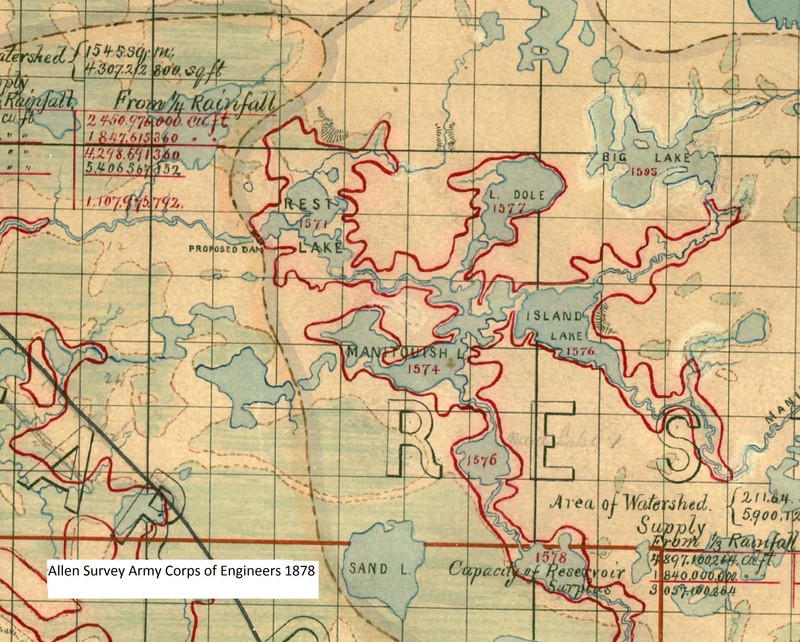
1909 view of the Chippewa Lumber and Boom logging camp formally the Mississippi River Logging camp
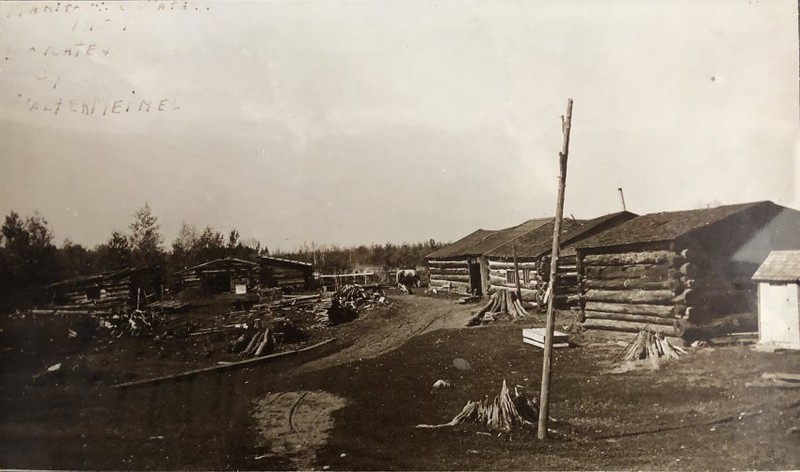
c1915 logging camp below Rest Lake Dam
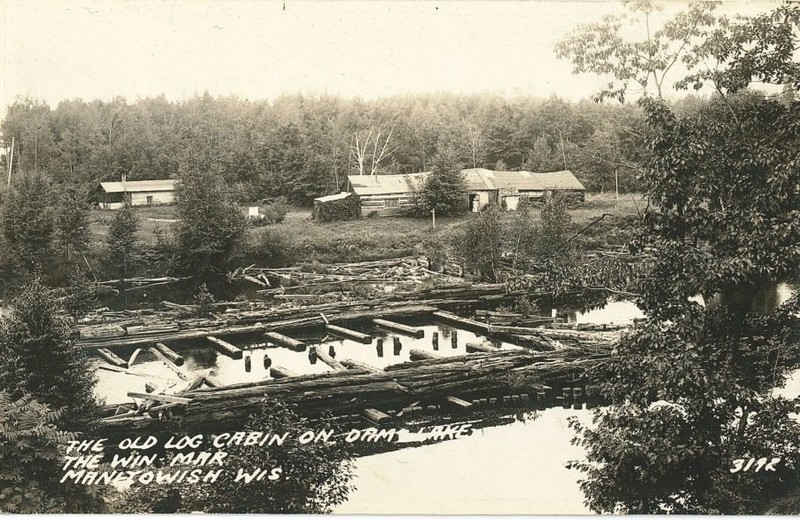
1917 Map of Chippewa & Flambeau Improvement Co. properties
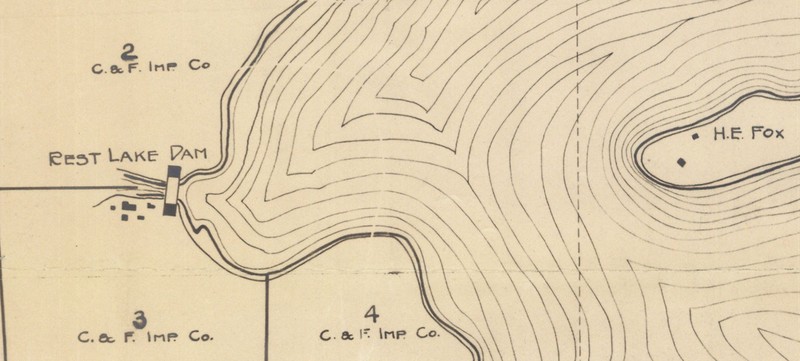
Rest Lake Dam and logging camp with gate wheels
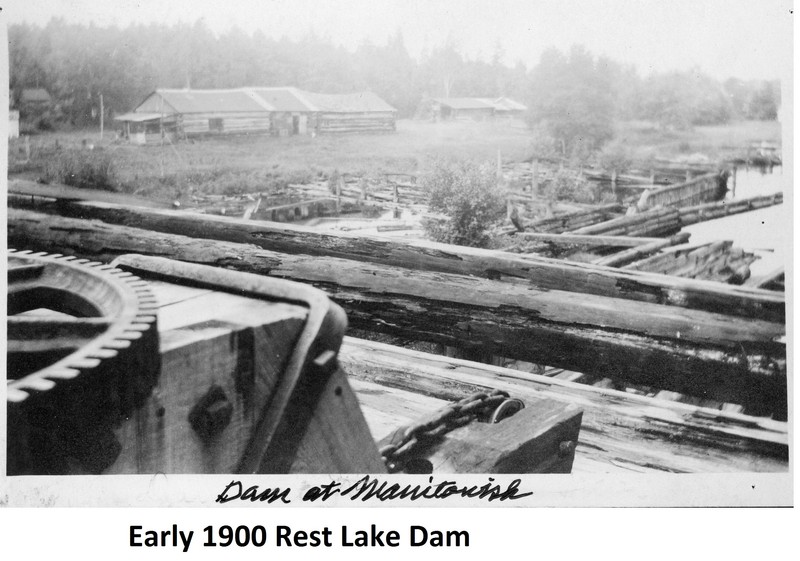
Rest Lake Dam with logs in the sluice
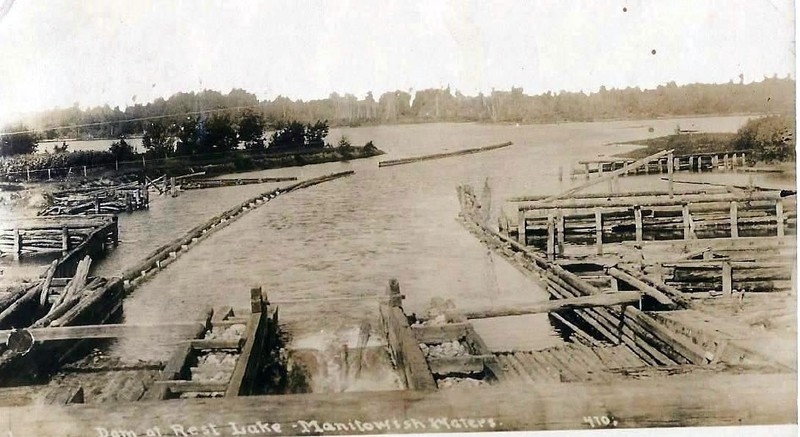
1899 image of Rest Lake Dam (down stream view) before being rebuilt
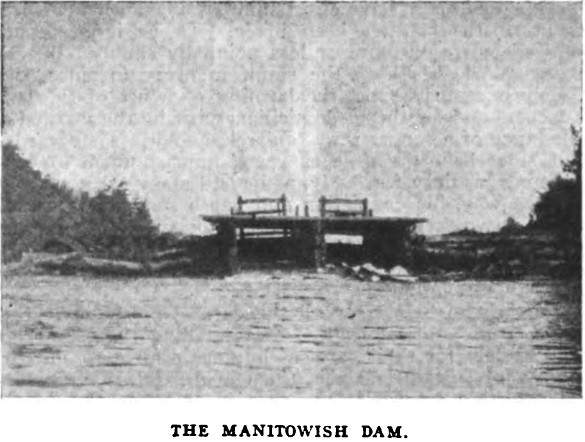
c1940 Rest Lake Dam image
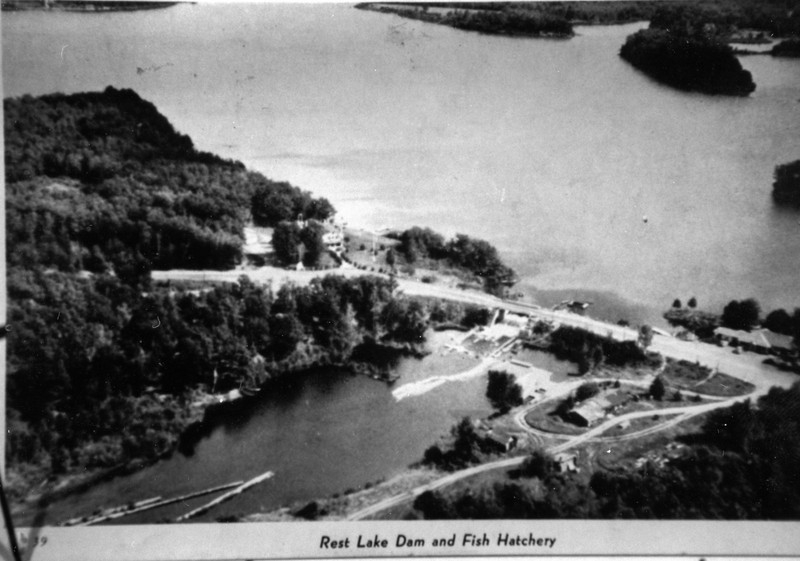
Backstory and Context
Text-to-speech Audio
Phase 1 white pine loggers in Manitowish Waters were controlled by Fredric Weyerhaeuser’s Pool or Syndicate of 100 silent partners who monopolized much of the white pine logging along the Manitowish River basin.(1) The Mississippi River Logging Company, the Chippewa Lumber and Boom Company along with a few other Eau Clare-based logging interests continued their domination of white pine logging on the Chippewa Basin.(2) Consequently, Manitowish Waters’ area log drives were some of the longest in Wisconsin. Historian Michael Dunn reported that early dam construction at Rest Lake required materials moved by rail to Park Falls, Wisconsin to be rafted upstream to the dam site in 1887-88.(3)
In 1878, the Army Corps of Engineers conducted a series of surveys along the Chippewa River to facilitate dam construction, mostly for phase 1 river drive logging and flood control. Captain Charles Allen led these surveyors, but his assistant Mr. J. H. Dager led the survey for the Rest Lake Dam. Dager and his men proclaimed the Rest Lake Dam site as excellent, able to hold back 25 feet of water.(4) Interestingly, after extensively researching and documenting a 25-foot head of water at the original dam site located a few meters downstream of the outlet of Vance Lake, the U.S. Congress changed the height of the dam to 15 feet in 1880.(5) Ultimately, the dam was moved upstream to its present location at the outlet of Rest Lake, likely because a local resident like Peter Vance might have suggested the goal of a 15-foot dam could be achieved at the Rest Lake outlet site with a fraction of the construction. Later, two other phase 1 river drive dams were constructed upstream of the Rest Lake Dam on the Manitowish River: one at the outlet of Boulder Lake on Highway K and another creating a flowage below Fish Trap Lake. A lesser-known dam was authorized for construction on the Trout River rapids by the modern golf course, but its historic status remains unclear.(6)
In 1884, Peter Vance claimed to settle on Vance (formerly Dam) Lake after traveling by canoe from Menomonee, Wisconsin or Eau Claire, Wisconsin as a timber cruiser, suggesting Vance worked for the Weyerhaeuser Pool and thereby avoided rail transport. Vance likely was one of the last few timber cruisers sent before the construction of the first Rest Lake Dam. Some histories suggest that Peter Vance and his Ojibwa wife Sarah Mitchell Vance were the first long-term settlers of Manitowish Waters during the logging era.(7) Recent research strongly suggests that Dan Devine and his Ojibwa spouse Kate settled on Clear Lake at least five years earlier, making the Devine family our communities’ first logging era settlers.(8) Dan Devine Sr. was a Civil War veteran who reportedly worked for logging companies, guided, trapped extensively, operated a resort/camp, and developed strong ties to traditional Ojibwa practices.
The ownership, construction, location, regulatory authority, and jurisdiction of the Rest Lake Dam has been debated since its inception. By 1916, the early debates regarding the Rest Lake Dam were mostly settled by the Wisconsin Supreme Court. Judicial documents reveal that in 1887 the Chippewa River Improvement and Log Driving Company under the ownership/authority of Charles Henry received legislative charter to build the Rest Lake Dam.(9) Construction of the first dam concluded in 1888 and was built by the Chippewa River Improvement and Log Driving Company. At the same time, most historians support Chippewa Lumber and Boom Company claims to have run logging operations, controlled dam operations, and occupied a camp just south of the Rest Lake Dam. Frederick Weyerhaeuser actually “owned” or controlled both the Chippewa River Improvement and Log Driving Company and the Chippewa Lumber and Boom Company.(10) Continuing this ownership trend, some references from Paul Brenner suggest the Weyerhaeuser’s Mississippi River Lumber Co. also dominated timber ownership and phase 1 river drive logging in the area.(11) Recent research of deeds in the area of the Rest Lake Dam suggest Weyerhaeuser’s Mississippi River Lumber Co. actually owned the land on Rest Lake until 1902, and only transferred ownership to the Chippewa Lumber and Boom Company because the Mississippi River Lumber Company was to be dissolved in 1909.
For the purpose of clarity and consistency going forward, the Weyerhaeuser entity controlling the Rest Lake Dam properties will be cited as Chippewa Lumber and Boom Company to align with nearly all modern historic accounts. Acknowledging that as the lead entity of the “syndicate,” Weyerhaeuser’s Mississippi River Logging Company owned the Rest Lake Dam area land and much of the land in the region from 1887 until the early 1900s, during virtually all of the phase 1 logging.(12)(13)
The size, engineering and capacity of the Rest Lake Dam are disputed among local historians. Paul Brenner’s research suggests that in 1888 a low dam at Rest Lake was constructed and later replaced by a high dam by 1892.(14) Michael Dunn suggests: “In 1887 the state legislature authorized the lumbermen to build a dam there to pen up waters of the chain for logging and river driving. In 1887-88 crews built a camp below the dam site and began freighting in the first supplies upriver from the railroad at Fifield and Park Falls. They also began grading the earthworks on either bank and began building rock crib and timber dam tall and strong enough to hold back water fifteen feet deeper than the chain had ever seen before!”(15)
In 1902, Ironwood resident James Albright recorded that Fox Island was eroding from the dam raising water more than 12 feet for logging operations. In addition to citing extreme erosion, Albright estimated the size of Fox Island to be 20 acres. Today, tax records reveal that Fox Island is slightly larger than nine acres. Early dam operation in support of logging ravaged the original shores of Manitowish Waters.
By 1914, early court documents regarding a dispute between Manitowish Waters’ residents and the Chippewa & Flambeau Improvement Company regarding dam operations evidenced the dam was in terrible disrepair and needed to be fixed immediately.(16) Michael Dunn observes that many of the repair issues regarding the Rest Lake Dam were resolved in the 1920s: “The reservoir company replaced the wooden dam with the present masonry dam in the mid-1920's.”(17)
Even though railroad construction of the Chicago Northwestern reached Lac du Flambeau in 1888 and Powell and Manitowish in 1889, phase 1 river drive logging dominated Manitowish Waters logging until at least 1900. The final river drives were concluded in 1904 as the Milwaukee Road spur reached the northern part of the Manitowish chain in 1905, joining the unique Little Star Lake spur built for the Flambeau Lumber Company, which had begun logging operations in 1900.
Phase 1 logging required the Rest Lake Dam to maximize white pine logging and river drive operations. Earlier logging was limited due to varying spring runoff and occasional make-shift dams. Possibly by 1888, and certainly by 1892, the Chippewa Lumber and Boom Company could hold back 16 feet or more of spring runoff to drive logs. Actually, logging companies would release and rebuild dam reserves throughout the spring to flash logs downstream. Court records reveal that from April until June, water levels would rise and fall several feet per day with no warning due to these practices.(18)
The most intense white pine river drives in Manitowish Waters took place between 1888 and 1897.(19) The Chippewa Lumber and Boom Company camp where the Pea Patch Saloon property is currently located was the area’s most documented lumber camp. The camp was built using the classic Dingle design from the logging traditions of Maine. The Dingle was a cold space that essentially linked the bunkhouse to the cook house/dining area. The river drive camps looked like one big building, but it had three distinct internal rooms.(20) A Dingle took about two weeks to build and could house dozens of lumbermen mostly during winter and spring. An early sportsman adventurer traveling from the rail stops at Eagle River to Manitowish by canoe describes the Rest Lake camp in 1890: “The dam was 3 miles below and we were trying to reach it before dark. We made it, but had no time to lose, in a half an hour after we pulled the latch string on the dam-keepers shack, we sat down to just such a meal as a logging camp cook always knows how to spread before sportsman, who have been working hard and living on fish and grouse straight for a week. We arose the next morning at the usual rise in time and logging camps, 2 o'clock, and long before daylight we were ready to start.”(21)
Today, residents and visitors in Manitowish Waters can enjoy drinks and dining on the same historic logging camp property at the Pea Patch Saloon. Looking toward the dam while seated at the Pea Patch, imagine the experiences of 1890 tourists at a river drive lumber camp. If you have difficulty imagining the logging era, just look at the top of the bar for dozens of images, celebrating historic Manitowish Waters. Owners Lisa (LaPorte) Hopkins and her husband Barry encourage visitors to use the deck or walk toward the river and witness the many pilings that remain form the logging era. Lisa’s uncle Cal LaPorte claimed that the LaPorte family led the last river drive of white pines in the early 1900s.
The unique culture and traditions of river drive logging camps, as well as the dangerous log drive journey to Chippewa Falls or Eau Claire are well chronicled by local historians Paul Brenner and Michael Dunn. Wherever possible, the citations of these historians will be included to illustrate the Manitowish Waters area river drive logging. Below, Michael Dunn provides an excellent overview of seasonal logging practices, supporting Manitowish Waters phase 1 white pine river drive logging:
"The Chippewa Lumber and Boom Co. opened the logging age here. In 1892 CL&B forces built the Rest Lake dam with heavy timbers, three spillways and huge iron bullwheels to control the gates; the same year its men also built a steamboat with a backbone of tamarack and cedar ship knees hewn on the Island Lake shore. For the life of the CL&B activities here, the most exciting event of the year was the log drive. For several weeks early each summer pine logs were sent through the spillways in great bunches and washed downstream with huge gulps of penned up lake water. The river might then be a solid mass of logs for many miles. Skilled drivers prodded them along. Leading and trailing the drives were wanigans or cook boats, built below the dam for each year's drive. It took almost all summer and the efforts of up to two hundred men to push the drive all the way to its Chippewa Falls area destination. The rest of the year lumberjacks who lived in long, low, log camp buildings below the dam labored to replenish the log supply held behind the dam in preparation for the next season's drive. They took only the finest of pine, so light that it could float indefinitely and was called cork pine; in the winters teams and sleds pulled the newly felled timber to the icebound shores; in summer giant wheels were used. On the waters of the lakes, raised up to sixteen feet above their original level by the new dam, and thus spreading over a much wider area, the steamboat worked almost round the clock to shepherd huge rafts of logs to the dam. The boom, however, could not go on forever, and by the early 1900s and certainly by 1906, the crude little paddle wheel steamer, its whistle stilled, lay pulled up on the shore where modern day water skiers stage their shows. A few families clustered around the dam, which deteriorated and even was left open for a while; the landing where boats met travelers was located on the present Ilg property. The horses, ponies and wagons were kept there and a man named James McKinney kept a tavern there before 1910."(22)
Clearly, the fledging community of Manitowish Waters was emerging from the Chippewa Lumber and Boom operations and the expanded chain of lakes, resulting from the Rest Lake Dam. Rail access to nearby Manitowish and Powell rail stations provided both supplies and passengers to support a budding tourist industry all before 1900.
Historic logging expert Paul Brenner also shares phase 1 river drive logging analysis, with specific insights regarding the stamping, driving and scaling of white pines for market. Below is Brenner’s narrative from a recorded interview: "Now getting back to the oldest logging, the stuff that was sleighed to along the lakes and the rivers in our area the Manitowish River and the Rest Lake Chain and stuff like that. The loggers built a series of dams to raise the water up considerably and they had one at Rest Lake which is where Manitowish Waters is now. They also had one below Boulder Lake which is near the junction of highway "H" and "K." And they also had one further up stream called the Fish Trap Dam which raised the water all the way up to High Lake. Now I think they raised the water up in the fall so that once they started getting ice they could put logs right on the ice if they could get to the lakes because of the banks. But if not then they decked them along the edges of the lakes and rivers and then when the ice went out in the spring they'd roll the logs into the water and they'd float down ever so slowly but they'd float down. At the Rest Lake Dam there is, I have a series of pictures here that show the Rest Lake Dam. Unfortunately not where we could see any logs going through it. This other picture is the Boulder Lake Dam. I'm sure this is when they were using it but they don't show any logs coming through it. So they'd keep the gates closed on the dam until they'd get a head of water and a load of logs behind it. And then they'd open up the dams and what that caused was raise the river down below the dam for quite a ways and it would sluice the logs down over maybe so Log jam and hoist/boom between Vance and Sturgeon Lakes me bad spots. Then the rest of the water would be deep enough that the logs would float ever so slowly. They figured one log out of ten never made it to the mill because they either sank or they got stuck in places where they couldn't get them back into the main current.
"Now at the time that all these dams were built there were many companies using the same rivers and lakes and they had to have a way of sorting the logs after they got down to where the mills were. In our case the logs went all the way down to Eau Claire and Chippewa Falls. This particular picture shows a man that was both scaling the log which means that he was measuring the board feet that were in the log and at his toe you can see a small hammer. These hammers have raised letters or numbers or all kinds of things. They could be anything. There were thousands of them registered just in this one lumber district and there were ten or twelve lumber districts in Wisconsin. Both ends of the logs were usually marked anywhere from one to ten times depending how big the logs were. By this method when the logs got down to the mills they were able to sort them out, each company having their own marks."(23)
Importantly, Michael Dunn has additional insights and details regarding river drives that corroborate Brenner’s narrative: "Every few days a gate in the dam was opened and a large batch of logs was sluiced through, followed by a dose of water large enough to assure that the logs would float freely downstream but not enough to wash the logs ashore along the river's wandering course. The sluicing lasted only a few weeks, but took place every spring for ten to fifteen years."
As the logs moved downstream, log driving crews shepherded them to prevent jams and to get stray logs back into the flow. The most colorful fixture of the log drive was the "wanigan" that accompanied the drive. It was the kitchen boat that was built on the flat below the dam: A scow with a house on top to enclose the kitchen, supply space and sleeping quarters for the cook. Each evening, the log drivers would gather at the wanigan for a hearty supper and maybe a little singing before they separated to sleep in little tents or just under the stars. All the dams below the Rest Lake Dam had gates big enough to allow it to be sluice through, guided by its big oars.
The logs were boomed and sorted and fed into the huge sawmills of the Chippewa Falls or Eau Claire area or some of them were sent on toward the Mississippi mills, and the wanigan was abandoned or dismantled.
Back at the dam here, when each drive was over, 2.5 billion gallons of water had been penned up and then released; the lakes were down to their original pre-1887 levels; and raw, ugly scarred new margin of erosion and stumps marred 50 some miles of the shoreline.(24)
As the phase 1 river drive logging came to an end in Manitowish Waters at the beginning of the 20th century, Paul Brenner shares evidence he discovered in 1982, corroborating both Weyerhaeuser’s influence and the end of the river drive phase: "Paul Brenner found a log in Rest Lake, in 1982, which he recognized as having been cut by the Chippewa Log and Boom Company of Chippewa Falls, WI. The mark was registered on October 2, 1902. The company camp was located just below the dam, behind the present-day Pea Patch restaurant."(25)
The transition between phase 1 river drive logging and phase 2 railroad logging blurred at the turn of the 20th century. Many practices, cultural behaviors, traditions and technologies migrated to phase 2 railroad logging. One of the most storied narratives regarding lumberjack traditions were the antics of hard drinking and brawling loggers. In the winter of 1895, during the transition between both phases of logging, an early sportsman, E. Hough, documented the drunken and violent behaviors he witnessed while visiting Manitowish and Woodruff. While traveling from the town of Manitowish to Circle Lily Lake to check a trap line with local guide Fay Buck, the author shares: "On this first day, as we were going along the logging trail which lead out of Manitowish, we came upon a man lying on his back on the snow in the middle of the road. He was motionless, and when I went up to him I thought he was dead, but at length saw he was only paralyzed by pine woods whiskey. He was dressed in the usual Mackinaw clothing, and thanks to which for the fact he was not frozen stiff. After much trouble we got him awake, and found he was only one of the tough "lumberjacks " common to the region. (I think the working population of the Pine woods is the lowest, filthiest and most degraded class of man I have ever seen in any part of the United States). 'I jist sit down for wance in a woy,' said this specimen, who proved to be an Irishman. 'D ye mind, I wuz waitin’ fur a felly, see?' We saw that to leave him alone was to allow him to freeze to death, so we drag and drove him along with us for a couple of miles, till we came to the logging camp, where we left him. As the keen air and exercise of walking (which latter in his case was violent) began to eliminate some of the effect of the awful liquor he had been drinking, he became first apologetic, then explanatory, then talkative, and finally belligerent. Northern country whiskey has a couple of fights in every drink, and it's chief characteristic began to show in our newly discovered friend."(26)
This revealing narrative then degrades into a nasty exchange of swearing, which illustrates the deep nativist and ethnic prejudice which was common at the turn of the 20th century: "An’ pfwhat moight be yer name, ye yeller-headed – – –? He said to me, as I walked ahead. 'An’ pfwhat is thim t'ings ye'er carryin over yur shou’hlder? (meaning the skis.) 'they’re my skis, you read headed – – – –,' said I to him, cheerfully. 'Umph-humph,' Said he, and lapsed into thought for a while, at last resuming: 'skees, it is, is it, eh? Thim is thim skates the Norwaygins uses, eh?' I told him he was correct, and for quite a while he was silent, but at length broke out with a snort of rage. 'Shore, if I’d a gun I kill ye, ye yeller-headed --------,' said he, 'There’s Norwaygins enough, in this yer counthry now!' This he said with an air of deepest conviction and I could only admit that he being a resident of the country, must be better acquainted with its condition and requirements than myself."(27)
The behavior described above fueled some reform-minded citizens to support temperance or even prohibition movements in this period and beyond. In the short and long term, it would be safe to assume that “dry” advocates were a minority in Wisconsin’s Northwoods.
E. Hough continued his travels to Woodruff to pick up a mail order camera and catch a train to Star Lake for more 1895 winter adventures. His time spent waiting for his camera revealed more lumberjack behaviors and culture which would cause “civilized” citizens’ great pause: "The village of Woodruff, Wisconsin is in the fishing season the port of entry for Trout Lake and the Manitowish muscallunge waters, and at that time it has a sort of transient life. In the winter season it is dull, squalid and tough with a toughness not easily to be paralleled. I think there is no population in America of so low a grade as the riff-raff of the lumbering regions. The small towns of the Western frontier are tough, but they have a brilliant wickedness which gives them a fascination of their own. The logging town is low, sodden, degraded, and does not rise to the dignity of wickedness. The inhabitants, or the transient loggers who enable the inhabitants to live, are assorted foreigners of beast-like habits and tendencies. Cleanliness is unknown. Dirt, vulgarity, depravity, low-downness are the characteristics that meet you. One can mingle with clean wickedness without personal discomfort, but dirty vulgarity is far worse in consequence. Even the style of fighting (and where cheap whiskey abounds fighting must ensue) is of poor type in the pinewoods. In the Rockies we used often to see gentlemen who were in there cups having disagreements, and pull their guns and shoot it out like gentlemen, others not interfering. In the lumbering regions the weapon is the fist and the hobnail. Etiquette demands that when one has knocked an enemy down he shall stamp upon him or pound him. Often half a dozen will set upon one man, and customs seems to dictate that all ones friends shall help him pummel a single adversary. Woe be to the “river jack” who starts into a fight without a "gang" behind him, for if the other man has a "gang "with him they will all go into action as soon as it seems safe. There are many nationalities, and the feuds between the different clans always break out at the bar where the red-eye moveth itself all right. All the hotels are small, and the bar in each is the biggest half. Quiet is there unknown. As I could not personally approve of the style of fighting customary in this region, I was a good deal bored during my three days stay at Woodruff, as I was waiting for my camera to come in from Chicago."(27)
E. Hough’s vivid lumberjack descriptions in the woods and taverns pull back the veil on loggers’ behaviors and culture. Contextualizing, Manitowish Waters historian Michael Dunn’s respectful insights regarding the popularity of area lumberjack taverns: “…the great logging days, a swashbuckling era during which you might have seen stuck into the ground in front of a tavern the pike-poles or canthooks of a hundred or more lumberjacks drinking inside.”(28)
Sources
1 https://www.immigrantentrepreneurship.org/entry.php?rec=239#_ednref29. Immigrant Entrepreneurship. Fredrick Weyerhaeuser. Retrieved 1-26-2018.
2 http://mwlibrary.blogspot.com/search/label/logging. Looking back at the logging years. Koller Library. Michael J. Dunn, III. Retrieved 1-26-2018.
3 Ibid.
4 https://mwhistory.org/2016/wp-content/uploads/2017/01/Allen-selected-journal-1878-1879-new-1.pdf.. Selections from Captain C. J. Allen Journal House of Rep. 45 Congress 1878-1879. Manitowish Waters Historical Society. Retrieved 2-3-18. Page 40.
5 https://mwhistory.org/secretary-of-war-journal-2nd-rest-lake-dam-1880/. Secretary of War Journal-2nd Rest lake Dam, 1880. Manitowish Waters Historical Society. Retrieved 2-3-18. Page 1607.
6 https://mwhistory.org/the-wisconsin-laws-and-joint-relolutions-1899-upper-trout-river-dam/. Wisconsin Laws and Joint Resolutions. Manitowish Waters Historical Society. Retrieved 2-3-18. Page 603-604.
7 http://mwlibrary.blogspot.com/search/label/history. A look back: the 19th century and earlier. Koller Library. Michael J. Dunn, III. Retrieved 1-26-2018.
8 http://mwlibrary.blogspot.com/search/label/devine%20family. low in the grave he lay. Koller Library. Retrieved 1-26-2018.
9 https://mwhistory.org/wisconsin-reports-164-cases-determined-by-the-supreme-court-of-wisconsin-1916-1917-rest-lake-dam/. Wisconsin Reports 164/Cases Determined in the Supreme Court of Wisconsin 1916-1917. Chippewa and Flambeau Improvement Co. Appellant, versus Wisconsin Railroad Commission, Respondent. Manitowish Waters Historical Society. Page 105-123. Retrieved 1-27-18.
10 Gates, Paul Wallace. The Wisconsin Pine Lands of Cornell University. The State Historical Society of Wisconsin: Madison. 1943. Pages 133.
11 Doolittle, Shirley. Boulder Junction The Early Years: 1880 to 1950. Published by Friends of the Library, Boulder Junction WI, 1996. P. 12.
12 Fries, Robert F. Empire In Pine the Story of Lumbering in Wisconsin. William Caxton Ltd: Sister Bay WI. Page 155.
13 Register of Deeds, Eagle River Courthouse. Eagle River WI. Vol. 20. Page 69. 1902.
14 Doolittle, Shirley. Boulder Junction The Early Years: 1880 to 1950. Published by Friends of the Library, Boulder Junction WI, 1996. P. 12.
15 http://mwlibrary.blogspot.com/search/label/logging. Looking back at the logging years. Koller Library. Michael J. Dunn, III. Retrieved 1-26-2018.
16 https://mwhistory.org/2016/wp-content/uploads/2017/01/1914-State-of-Wisconsin-Railroad-Com-Rest-Lake-Dam.pdf. Railroad Commission-State of Wisconsin: Rest Lake Dam 1914. Manitowish Waters Historical Society. Retrieved 2-4-18. Page 441.
17 http://mwlibrary.blogspot.com/search/label/logging. Looking back at the logging years. Koller Library. Michael J. Dunn, III. Retrieved 1-26-2018.
18 https://mwhistory.org/wisconsin-reports-164-cases-determined-by-the-supreme-court-of-wisconsin-1916-1917-rest-lake-dam/. Wisconsin Reports 164/Cases Determined in the Supreme Court of Wisconsin 1916-1917. Chippewa and Flambeau Improvement Co. Appellant, versus Wisconsin Railroad Commission, Respondent. Manitowish Waters Historical Society. Page 112. Retrieved 1-27-18.
19 Ibid.
20 Interview. Cynthia Stiles. Lac Du Flambeau Historic Preservation Office. Lac Du Flambeau, WI. 2-16-2018.
21 https://mwhistory.org/shields-magazine-1890-journal-from-presque-isle-to-manitowish-station-published-in-1907/. Shields Magazine:1890 Journal from Presque Isle to Manitowish Station-published in 1907. Manitowish Waters Historical Society. Retrieved 2-4-18. Page 87.
22 http://mwlibrary.blogspot.com/search/label/logging. Looking back at the logging years. Koller Library. Michael J. Dunn, III. Retrieved 1-26-2018.
23 http://mwlibrary.blogspot.com/search/label/logging, Paul Brenner, interview continued. Koller Library. Paul Brenner. Retrieved 2-4-2018.
24 http://mwlibrary.blogspot.com/search/label/logging. Looking back at the logging years. Koller Library. Michael J. Dunn, III. Retrieved 1-26-2018.
25 http://mwlibrary.blogspot.com/search/label/logging, Paul Brenner, interview continued. Koller Library. Paul Brenner. Retrieved 2-4-2018
26 https://mwhistory.org/2016/wp-content/uploads/2017/02/Forest-and-Stream-1895-logging-trapping-Buck.pdf. How Fur Is Caught II. Forest and Stream. 1895. Manitowish Waters Historical Society. Page 486. Retrieved 2-5-18.
27 Ibid.
28 https://mwhistory.org/2016/wp-content/uploads/2017/02/1895-foreststream-logging-trapping-star-lake.pdf. How Fur Is Caught V. Forest and Stream. 1895. Manitowish Waters Historical Society. Page 588. Retrieved 2-5-18.
http://mwlibrary.blogspot.com/2012/06/history.html. "History...". Koller Library Dunn, Michael. Retrieved 6-7-22.
MWHS archives
MWHS archives
MWHS archives
Wisconsin Historical Society. "Map of Sec 9 - T42N - R5E showing property of the Chippewa & Flambeau Improvement Co." Image ID 98540. https://content.wisconsinhistory.org/digital/collection/maps/id/1899.
MWHS archives
MWHS archives
MWHS archives
MWHS archives
